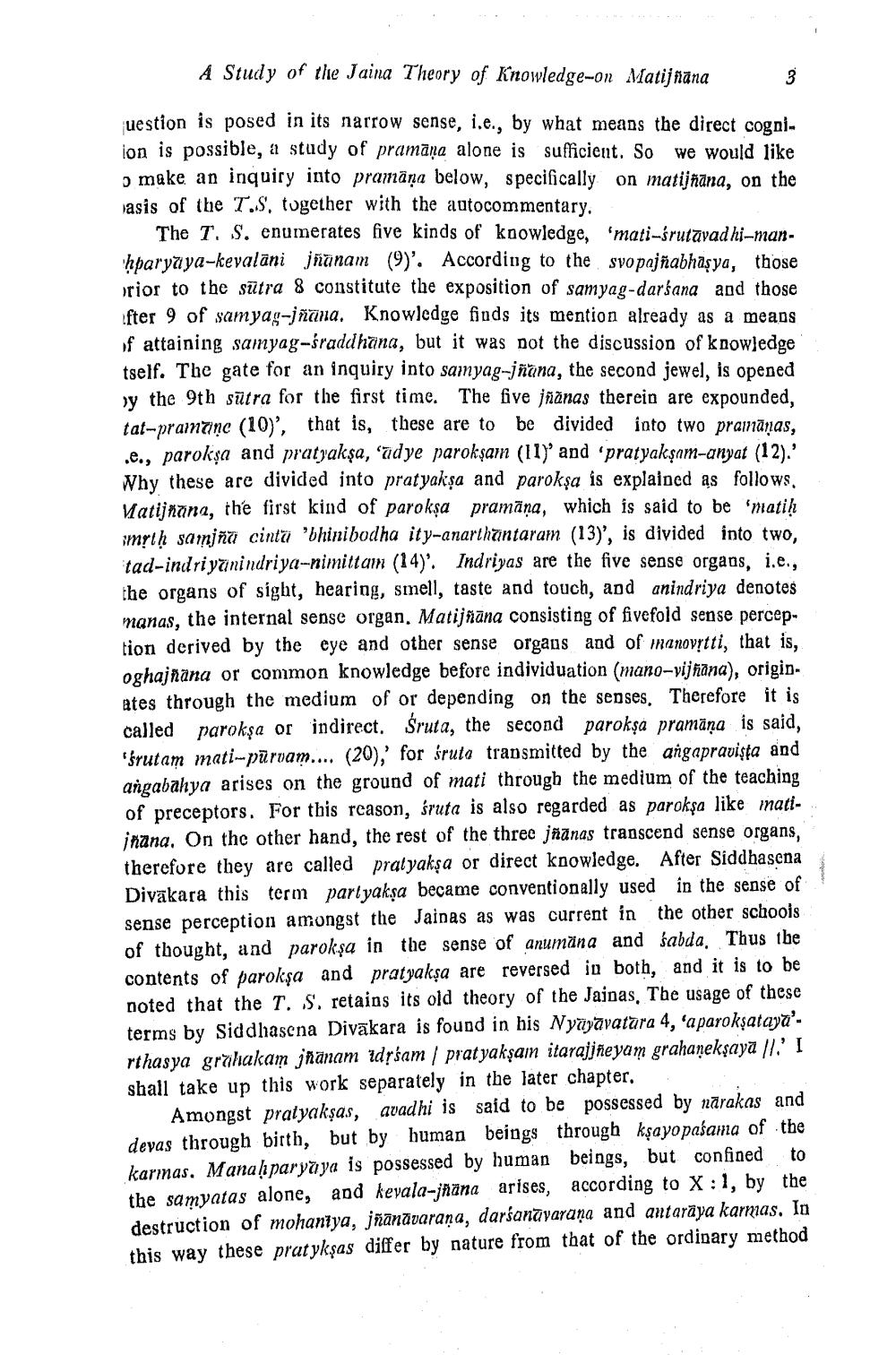________________
A Study of the Jaina Theory of Knowledge-on Matij frana
uestion is posed in its narrow sense, i.e., by what means the direct cogniion is possible, a study of pramāna alone is sufficient. So we would like
make an inquiry into pramana below, specifically on matijñana, on the jasis of the T.S, together with the autocommentary.
The T. S. enumerates five kinds of knowledge, 'mati--śrutavad hi-manhparyaya-kevalani jnanam (9)'. According to the spopajñabhaşya, those rior to the sutra 8 constitute the exposition of samyag-darśana and those ifter 9 of samyag-jñana. Knowledge finds its mention already as a means of attaining samyag-śraddhana, but it was not the discussion of knowledge tself. The gate for an inquiry into samyag-jñana, the second jewel, is opened y the 9th sutra for the first time. The five jñānas therein are expounded, tat-prainune (10), that is, these are to be divided into two pramānas, .e., paroksa and pratyakşa, 'adye parokşam (11)' and 'pratyakşam-anyat (12).' Why these are divided into pratyakşa and parokşa is explained as follows. Matijnana, the first kind of parokșa pramäna, which is said to be natih smrth samjña cintu 'bhinibodha ity-anarthantaram (13)', is divided into two, tad-indriyanindriya-nimittam (14). Indriyas are the five sense organs, i.e., the organs of sight, hearing, smell, taste and touch, and anindriya denotes manas, the internal sense organ. Matijñāna consisting of fivefold sense perception derived by the eye and other sense orgaus and of manovrtti, that is, oghajnana or common knowledge before individuation (mano-vij hāna), origin. ates through the medium of or depending on the senses. Therefore it is called parokşa or indirect. Sruta, the second paroksa pramana is said, 'frutam mati-pūrvam.... (20),' for śruta transmitted by the angapravista and angabahya arises on the ground of mati through the medium of the teaching of preceptors. For this reason, śruta is also regarded as parokşa like matiinana. On the other hand, the rest of the three jñānas transcend sense organs, therefore they are called pratyakṣa or direct knowledge. After Siddhasena Divakara this term part yaksa became conventionally used in the sense of sense perception amongst the Jainas as was current in the other schools of thought, and parokşa in the sense of anumina and sabda. Thus the contents of parokşa and pratyakşa are reversed in both, and it is to be noted that the T. S. retains its old theory of the Jainas. The usage of these terms by Siddhasena Divākara is found in his Nyayavatara 4, 'aparokşatayu'. rthasya grälakam jnanam rdrśam / pratyakşam itarajjñeyam grahanekşaya //.' I shall take up this work separately in the later chapter,
Amongst pratyakşas, avadhi is said to be possessed by närakas and deyas through birth, but by human beings through kşayopasama of the
to karmas. Manah paryaya is possessed by human beings, but confined the samyatas alone, and keyala-jñana arises, according to X:1, by the destruction of mohaniya, jñānāvarana, darśanavarana and antarāya karmas. In this way these prat ykşas differ by nature from that of the ordinary method




